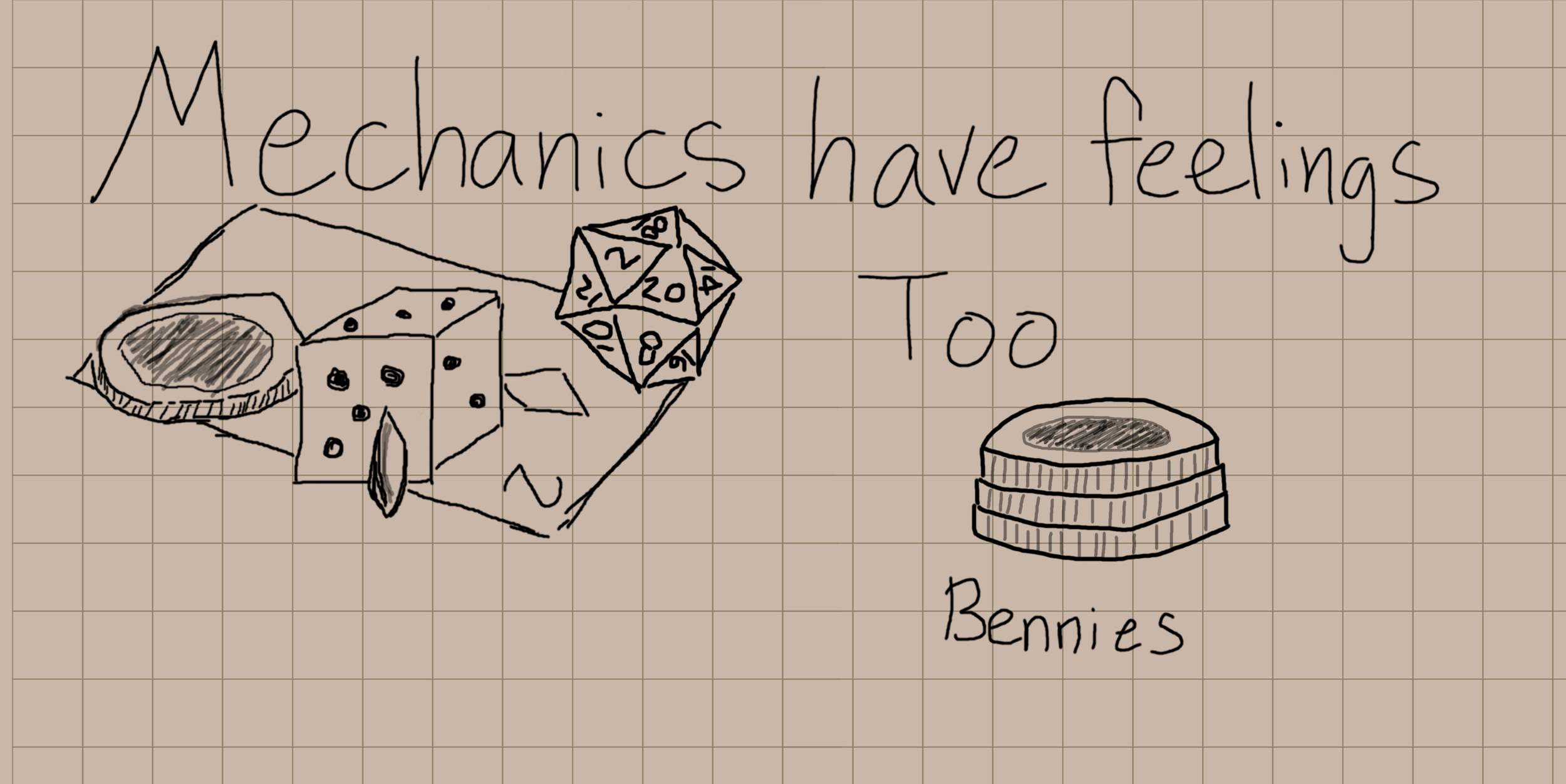Mechanics Have Feelings Too: Bennies
Mechanics Have Feelings Too: Bennies
Diving into tabletop game design comparing two common vitality mechanics
Brandon Gutowski, C22 System
Bennies, tokens, freebies, hero cookies—or whatever you call them—they're one of the most homebrewed mechanics in rpgs. Some systems have these in their rules in one form or another. Some GMs add them to every game, regardless of the rules, while others remove them from every game. At their very essence, they are a player-facing token you trade for in-game value. So, why do simple tokens warrant their own post? Because there are a lot of feelings wrapped up in these simple tokens. How they are implemented changes the game drastically.
Mechanically, what are bennies?
A benny mechanic is made up of three things: quantity, replenishment, and value. There are additional complexities if the GM can use them as well. I will not touch on the implications and feelings associated with GM facing bennies in this post. Today we’re focusing on the player side of bennies.
Quantity of Bennies
Quantity is simply the number of bennies you have at a time. When you have more, you can act more risky as you have a safety net, when you have fewer, you use them more sparingly.
Replenishment of Bennies
Replenishment is simply how you get more. This also includes a limit of how many you can have at once, and the circumstances where there is no replenishment.
Value of Bennies
Value is the most complex of the three mechanical aspects of a benny and where most of the design work for implementing a benny in a game comes in. Too much value, and the benny is only rarely used, too little and the benny is ignored. Furthermore, if the benny has multiple uses and there is a huge disparity between the perceived value of the options, the benny is only ever used for the option with the perceived highest value. In such cases, the value of the benny is the value of the strongest option.
For example, if you are playing an item-based post-apocalyptic survival game and your benny options are to re-roll a skill check, blink as a free action, or to prevent death. The third option has the highest perceived value. While it is true that re-rolling a skill check would almost always be the way to prevent death, it is not guaranteed. The way the benny value is written to prevent death itself has the highest perceived value. The players will almost always play to their optimal advantage, so in this case bennies held becomes the number of extra lives the players have.
This looks like it gives us three knobs to adjust in design, but quantity and replenishment are really just two sides of the same thing. While “how the bennies are replenished” is an interesting design space, it ultimately results in more quantity.
Value vs Quantity
As true in game design as it is in life, the plentiful things are worth less than scarce things. But let’s look at why by looking at the four cases: high qty and high value, low qty and low value, high qty and low value, and low qty and low value.
High Qty + High Value
High quantity and high value means that you have a large number of impactful actions you can take. This results in your roleplaying game being about spending bennies. It takes on a more board game type feeling with limited resources. This is not necessarily a bad thing. This can work very well for unique mechanics in one-shots or to codify when a player can make a significant world-level change in a story game. Use this setup if you want your game to mechanically have a benny-centric feeling. Whatever mechanics you have assigned to the benny takes the main stage with this setup.
Low Qty + Low Value
Low quantity and low value means that you have a very limited amount of nearly insignificant actions. This results in your benny being forgotten. I do not recommend this set up for roleplaying games as this would be a sign of feature creep or mechanics bloat.
High Qty + Low Value
High quantity and low value means that you can take a lot of actions of low impact. This frees the player to spend the bennies as they know they will have more, but also keeps their impact manageable. This feels freeing to the player without being stressful to the GM. Let’s look at a few examples to better understand this setup.
In a traditional dungeon delving game, say a benny grants players the ability to describe something in a scene. While the game is mostly about combat and problem solving, this can work to give players a codified signal to contribute to the narrative as well. In a game about high school teens looking to remove the local gang’s influence from their school, say a benny allows them to pause the narrative to take an in-character moment based on their character’s traits. In both of these cases, we can see how to nurture this freedom while encouraging shared roleplay, just with bennies.
Low Qty + High Value
Low quantity and high value means you can take one or two high impact actions. This is a classic setup for traditional games. This makes the player feel powerful and gives them another resource to consider while limiting the stress on the GM to only a few moments. Often this is used for re-rolls or threat resolutions. This setup is used in Savage Worlds, Fate, Deadlands, and Genesys to re-roll dice, soak damage, encourage roleplay, or use special powers. It feels classic and is easier to balance than any of the other setups due to the easily tweakable numerical quantity aspect.
<SUB> Types of Replenishment
We saw how important quantity is to the mechanics of bennies so naturally, how that quantity is achieved is equally important. This is where you can get creative with the quantity aspect of bennies. There is one important thing to remember: guaranteed replenishment frees players to spend bennies more, thus using your mechanics more.
I want to look at three classic methods: session start, subjective milestones, and mechanical milestones.
Session Start
Session start is a simple way to control quantity, Savage Worlds, Fate, and Genesys all do this. You get a set number of bennies to spend at the start of a session allowing players to interact with the mechanic right away. It encourages players to spend them throughout a session because they know they will get more the next time. The shorter the session, the stronger this effect is.This also creates a bit of urgency or sense of loss in the player for those that did not spend their bennies at the end as it feels like a waste of potential when not used.
Subjective Milestones
Subjective milestones are rewards for good roleplaying during a session. FATE and Genesys both use this method. This can encourage people to branch out and roleplay more who would not often roleplay, but can sometimes feel like a popularity contest or can just devolve into a “who said the funniest thing” depending on the group.
<Sub-sub> Mechanical Milestones
Mechanical milestones are rewards for story objectives or personal character goals. Genesys uses this method. This encourages players to keep moving the narrative along and can be good to help focus groups that tend to get distracted. This can end up as a win more mechanic since you are often already winning when you complete an objective. Another result can be a poorly paced power infusion if the objectives are significantly varying in their efforts to complete.
In each case of milestones, the replenishment trigger is used to encourage player behavior. Yeah, it feels weird to compare us all to Pavlov’s dog when it comes to bennies, but be honest with yourself, you’ve been salivating every time I have said the word benny. Benny, benny, benny.
Summary
For a simple token there is still a lot of design space to be explored. When looking at the dichotomy of quantity vs value you have three classic cases to consider. Your classic low quantity vs high value is the simplest and easiest to implement and feels right at home in many roleplaying games. The rarer high quality vs low value can be tricky to implement right but can add a sense of lightness and low stress encouragement for the players and GM. Finally, the high quantity and high value case can work to emphasize a mechanic and plays well in one-shots.
Whichever of the three dichotomies it is, the benny is more than a piece of plastic that sits in front of you, it is an impactful addition to how players experience the game. Take time to consider how that value and quantity pushes your decision-making in your favorite games. Then, tell me about it in the comments below!
This article is part of the Indie Game Developer Network’s blog series. The content of this article reflects the views of but one member of the IGDN. This IGDN blog article is brought to you by Brandon Gutowski of the C22 System. If you want to get in touch with the contributor he can be reached on Twitter at @c22system, on Facebook @PagodaGamesLLC, or visit their website at www.c22system.com.

